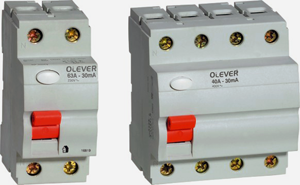The name Earth Leakage Circuit Breaker (ELCB) was given to a device that breaks the power supply when a fixed amount of current ,say 25-40 milli amperes flow through the earth line. The MCB (Miniature Circuit Breaker) is a device designed to protect a circuit’s wiring from the serious damage which would be caused if it has to carry a current which is too high for the diameter of its wires. The ELCB is now called as Ground Fault Circuit Interrupter (GFCI).

It is a basic fact that, all current flowing to electrical equipment from the power generation station via its supply circuit’s phase or neutral wire should only return to the power station via that same circuit’s neutral wire. If there is no fault anywhere in a circuit supplying single-phase, the current flowing to the unit at any instant in the “live” wire should exactly match the current flowing away from the unit in the neutral wire. Similarly, there should be no current flowing in the unit’s safety “earth”. If any current is flowing in the ground wire, it must be caused by a fault condition and the supply of current to the circuit needs to be stopped urgently.
ELCB


ELCB Circuit
MCB
The Miniature Circuit Breaker is a device designed to protect a circuit’s wiring from the serious damage which would be caused if it has to carry a current which is too high for the diameter of its wires. Such a current could easily heat up the wires so much that their insulation melts. If that situation were allowed to develop further it would soon cause the wires in a cable to short out and to burn so hot that they could easily cause a house fire.

MCB
Before circuit breakers were invented, simple wire fuses were used: the wire in the fuses was deliberately made much thinner than the wires in the circuits they were intended to protect. Thus, if a fault condition occurred, as the current in the circuit grew higher and higher, a point would be reached at which the thin wire of the fuse would get so hot that it would melt – all safely contained within the body of the fuse – and thus break the flow of current in the circuit it was protecting.
The problem with fuses is that – depending on their design, as some are faster-acting than others – it can take a significantly longer amount of time for them to operate compared with today’s very-fast-acting circuit breakers. That fact means that, if a circuit overload current fault condition occurs, considerable damage can still occur both to the circuit wiring and/or to the unit it is supplying with power.
Filed Under: Electronic Projects


Questions related to this article?
👉Ask and discuss on Electro-Tech-Online.com and EDAboard.com forums.
Tell Us What You Think!!
You must be logged in to post a comment.